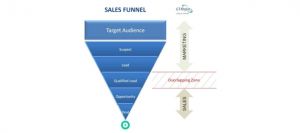 The typical sales funnel starts from Target Audience and goes through various stages like Suspect, Lead, Qualified Lead, Opportunity until it ends with the Deal. It’s jointly owned by Marketing (which includes product management, business development, marketing communications) and Sales (which is comprised of presales and field sales functions). Since times immemorial, there has been a debate around when marketing ends and sales starts. With the onset of channel marketing, inside sales, sales enablement and other relatively new functions, this debate has intensified in recent times.
The typical sales funnel starts from Target Audience and goes through various stages like Suspect, Lead, Qualified Lead, Opportunity until it ends with the Deal. It’s jointly owned by Marketing (which includes product management, business development, marketing communications) and Sales (which is comprised of presales and field sales functions). Since times immemorial, there has been a debate around when marketing ends and sales starts. With the onset of channel marketing, inside sales, sales enablement and other relatively new functions, this debate has intensified in recent times.
At a high level, every employee must work towards achieving the company’s goals. Since customer acquisition is arguably the most important objective for a company, it follows that everyone working for it should think and behave like a sales / marketing person. If this be the case, is it even worth discussing the boundary between marketing and sales?
Yes.
We find the analogy with football / soccer useful in this context. It goes without saying that all 11 players in a team should play to win. That means scoring goals. However, it doesn’t mean that every player should try taking the ball to the opponent’s goal post – that would result in utter chaos and guaranteed defeat. That’s why there are well-defined tasks for different positions in football. For example, a midfielder should function as the link between defence and attack. Players are expected to play according to their roles except under extreme circumstances.
Similarly, running a company requires clearly defined roles-and-responsibilities for different functions. Without them, each function will overstep its mandate and the organization will quickly turn dysfunctional. This already happens in many companies where, for example, the product / engineering manager would neglect to fix key product issues but teach a salesperson how to sell; the salesperson wouldn’t know how to sell without making overcommitments but lecture a delivery manager about how to ensure customer satisfaction, and so on.
Applied to marketing and sales, marketing clearly owns the Product / Capability to Lead cycle and sales takes responsibility for the Opportunity to Deal stages of the sales funnel. We believe that the role of marketing ends when it delivers its “deliverable” to sales, where “deliverable” can mean lead, opportunity or anything in between that’s mutually agreed between the company’s marketing, sales and top management. Having said that, the handover between marketing and sales should be a two-way street: If a lead “thrown across the wall” by marketing to sales later turns cold for whatever reason – change in management at prospect organization, for example – marketing should take the lead back and nurture it until it is adequately qualified to be handed over to sales again.
Quite often, the space between lead and opportunity is a gray area. If the lead is ready-to-buy, sales should drive the conversion of lead to opportunity, using sales / presales content like Capability Presentations, Case Studies, Approach Documents, Product Demos and Proof-of-Concepts. If the lead is not ready-to-buy, marketing should own this process and use marketing levers like newsletters, blogs and social media updates to nurture the lead until it becomes ready to buy, at which point marketing should hand over the lead to sales.
Like all processes and frameworks, this one should also have a certain degree of flexibility. Just as a goalkeeper shouldn’t hesitate to aim his or her goal kick directly at the opponent’s goalpost if s/he finds it unguarded.
Hello very nice blog!! Guy .. Excellent .. Amazing ..
I’ll bookmark your blog and take the feeds additionally?
I’m satisfied to find a lot of useful information here in the put up, we want develop
more techniques in this regard, thanks for sharing.
. . . . .